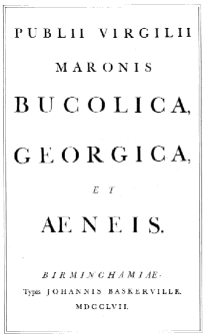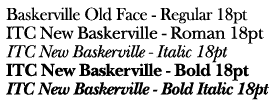 |
|
|
|
His first work in type, the Virgil, was published in 1757, in royal quarto (12 1/2" x 10"). His typeface designs were in the modern, pseudoclassical style, with level serifs and with emphasis on the contrast of light and heavy lines, they were more delicate, with more contrast in stroke widths. This style influenced that of the Didot family in France and that of Bodoni in Italy. These designs were unusual and innovative. Baskerville introduced new printing technology in order to use them. In particular, Mr. Baskerville was credited with the invention of hot-pressing: pressing the wet printed sheets between copper plates, thereby smoothing the paper and setting the ink. Books printed by Baskerville are typically large, with wide margins, made with excellent paper and ink. His work was known for its austere, unornamented style, and was widely criticized in his lifetime. Today, his typefaces are seen as a transition between the "old style" type such as Caslon and the "modern" type style exemplified by Bodoni. Among Baskerville's publications in the British Museum are Aesop's Fables (1761), the Bible (1763), and the works of Horace (1770). John Baskerville died in 1775.
Research Sources: Encyclopedia
Britannica: Biography of John Baskerville Typographic
Exemplars from RIT Library of John Baskerville's work |


